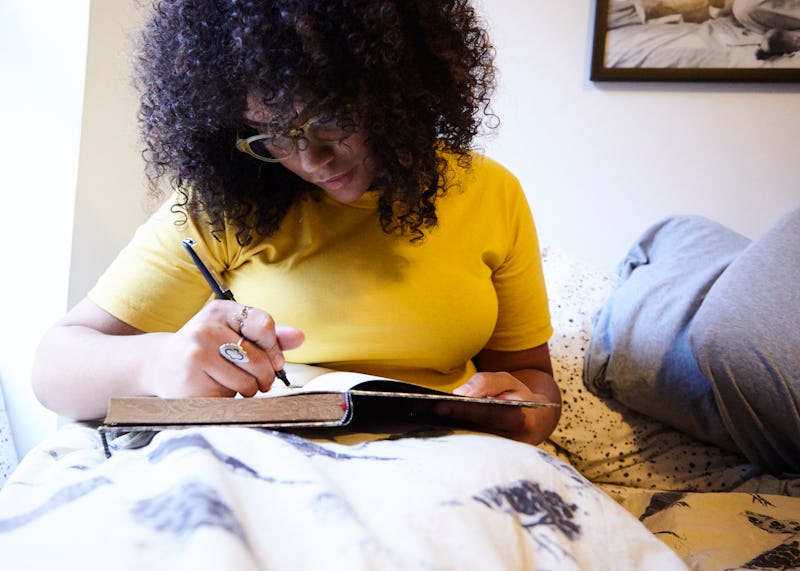The Practice And Science Of Drawing
Life
Drawing Can Change Your Brain In These 7 Ways, According To Science

Hannah Burton/Bustle
For some people, creating art is a passion, for others it's a hobby, and the rest would prefer to just admire art made by someone else. If you fall into that last category and haven't made art since hand-tracing turkeys in elementary school, you may want to try picking back up this creative hobby. Why? Science has shown drawing can change your brain — often times, for the better.
According to OZY, painter Pablo Picasso once said, "Art washes away from the soul the dust of everyday life." While visual art may have always been considered fulfilling and good for the soul, research is also discovering it's really good for your brain, and overall sense of wellness. Whether you are painting, drawing, sculpting, designing, collaging, making any kind of visual art — in any medium — packs a positive punch when it comes to your health.
It may be difficult to feel comfortable (and not judge your art!) working with clay or picking up pastels if you aren't an experienced artist. However, you don't have to be a trained or "talented" artist to glean the growing list of health benefits that creating visual art has to offer. From alleviating depression, to improving your attention span, here are 7 ways that making art can positively impact you.
1
Drawing Improves Your Memory
As Artsy reported this past May, a 2016 study led by Yale University researchers "observed a phenomenon they termed the 'drawing effect' — that illustrating a word's meaning always leads to the highest levels of memory recall." So, if you're ever struggling to commit a big presentation to memory, sketching it out may help you better retain the information.
2
Art Making Reduces Anxiety
3
And, It Makes You Happier
Unsurprisingly, creating visual artwork can not only reduce anxiety, but it has been shown to mitigate depression in research. A study published in 2017 discovered that people with moderate or severe depression who participated in art therapy showed major improvement after just 10, hour-long sessions.
According to Psychology Today, a 2017 study conducted by researchers in Hong Kong found "clay art therapy" also seemed to have a positive impact on adults with depression.
4
Creating Art May Help Ease Physical Pain
Who would've thought that making art could have pain relieving properties? Matthew Solan, the Executive Editor of Harvard Men's Health Watch, explained in an article for the Harvard Health Blog that, "Art therapy helps lower the perception of pain by moving your mental focus away from the painful stimulus." He added, "It is not simply a distraction, but rather a way to teach you how to relax and alter your mood, so the pain doesn't control your emotional state."
Creating art won't completely take physical pain away, but it could be a useful tool when it coming to managing it.
5
It Can Make You More Resilient
Interestingly enough, drawing or making any kind of visual art could make it easier to deal with stressful or upsetting situations. According to a 2014 study published in PLOS One, creating art can improve your overall cognitive functioning, and lead to more "psychological resilience in adulthood."
6
Making Art Improves Concentration
Dr. Michael Posner, Professor Emeritus at the University of Oregon and an adjunct professor at the Weill Medical College of Cornell University, explained in a 2009 article for The Dana Foundation that because art improves cognitive functioning, researchers have hypothesized that performing any kind of art can improve your attention and focus.
"We know that the brain has a system of neural pathways dedicated to attention. We know that training these attention networks improves general measures of intelligence," wrote Dr. Posner. "We can be fairly sure that focusing our attention on learning and performing an art — if we practice frequently and are truly engaged —activates these same attention networks."
7
It Can Make You Even More Creative
Studies suggest that the more you make art, the more creative you'll become. Research from 2015, published in the scientific journal NeuroImage, revealed that college students studying drawing and painting actually became better artists. The increase of creativity was due to white matter in the prefrontal cortex reorganizing, which is pretty dang neat.
8
Whether you pick up a paint brush, sketch with some pens, or take a pottery class, making art can help you manage your mood and more. You might also just get a nice decoration out of it, too.
The Practice And Science Of Drawing
Source: https://www.bustle.com/p/drawing-can-change-your-brain-in-these-7-ways-according-to-science-15522774
Posted by: salazarequady72.blogspot.com

0 Response to "The Practice And Science Of Drawing"
Post a Comment